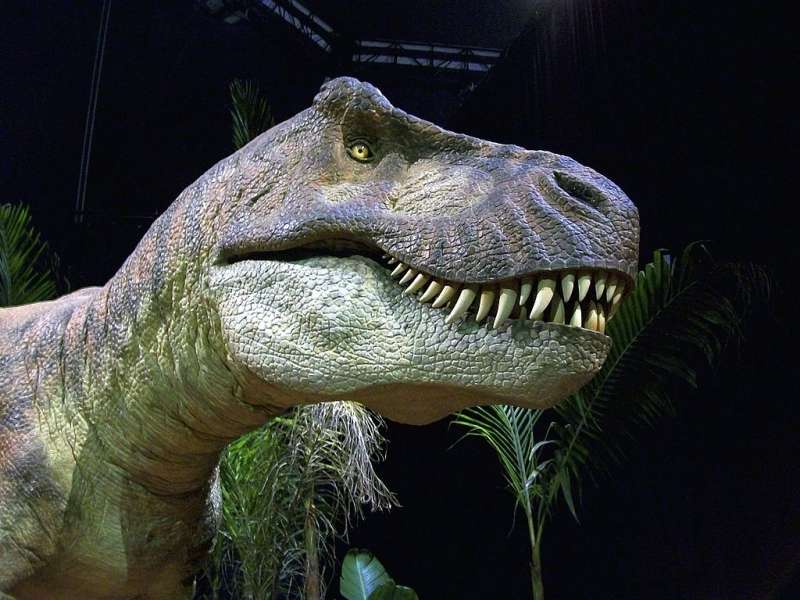Continued (Click here to read Part 3)
This is the fourth installment of our series, “Dinosaur Blood and the Real Age of the Earth,” and is a response to the book, “Dinosaur Blood and the Age of the Earth” by Fuz Rana of the Reasons to Believe organization headed by Hugh Ross. In Part 1, we took a look at the beliefs of Hugh Ross with special note taken of how Ross subverts biblical authority as a foundation to proclaim an old-earth theology. In Part 2 we looked at Rana’s Introduction and took special note of the nature of Rana’s argumentation as partisan polemics, and not objective scientific analysis. In Part 3 we examined Chapter 1, Rana’s citation of extant organic tissue from dinosaurs and other various organisms and the claim that they are millions of years old, with special note taken of Rana’s rejection of the empirical data contradicting this claim. Rana’s book is organized as follows:
Introduction: “What’s the Issue?”
Ch. 1: “Dinosaur Blood in Fossils: Who Would Believe It?”
Ch. 2: “Dinosaur Blood and the Case for a Young Earth”
Ch. 3: “Radiometric Dating and the Age of the Earth”
Ch. 4: “How Did Soft Tissue Survive in Dinosaur Fossils?”
Conclusion: “Should You Believe It or Not?”
Appendix A: “A Biblical Case for an Old Earth”
Appendix B: “The Creation-Evolution Controversy in Jurrasic World”
Appendix C: “Dinosaur Genome Size Estimates; Laggerstatten of Design”
In this article, we will be examining Chapter 2, “Dinosaur Blood and the Case for a Young Earth.”
Chapter 2: Dinosaur Blood and the Case for a Young Earth, pg. 31-35
“Young-earth creationists point to the discovery of soft tissue remains in dinosaur fossils (and fossil specimens of other creatures) as prima facie evidence for the scientific community’s philosophical adherence to an old-earth framework, contrary to the evidence. They are quick to highlight how strongly some paleontologists (and other scientists) resist the compelling evidence for soft tissue remnants in fossils—a resistance they claim arises out of a deep concern about the implications of the soft tissue discoveries; namely, that the fossils cannot be millions of years old.”—“Dinosaur Blood and the Age of the Earth,” pg. 29-30, bold emph. sup.
The discovery (or, rather, the acknowledgement of the discovery) of extant, original organic tissue from dinosaurs and many other organisms supposedly hundreds of millions of years old now has a short history behind it. I thought this present article as good a time and place as any to highlight one of the most revealing and telling aspects of this history, namely, the widespread denial by many evolutionists that any extant original dinosaur tissue has even been found at all despite all of the publications in peer-reviewed science journals demonstrating otherwise.
This denial continues to this day on the part of some as recently as February 1, 2017, according to Real Science Radio network. (Real Science Radio has, as far as I am aware, the most extensive documentation and citation and discussuion on the internet about soft dinosaur tissue and related issues from peer reviewed scientific publications and is an invaluable resource on this subject.)
In their web page on this subject, Real Science Radio reports, in part, the following list of those with a bad case of STD (Soft Tissue Denial):
– “Smithsonian Dinosaur Expert Brian Switek: 2012: As late at Sept. 27, 2012, Switek wrote, “The supposed dinosaur leftovers may be microfossils created by bacterial biofilms…”
-“ Oxford-educated widely-published anti-creation activist Paul Braterman: On March 8, 2014, wrote, “despite much hype the only surviving material is in the form of a collagen-bone composite.”
– “RationalWiki: The science deniers over at the atheist, anti-creation RationalWiki.org, as late as Feb. 1, 2017, are still denying the overwhelming hard science that has documented the existence of endogenous, extant dinosaur soft tissue.”
– “Talk Origins quote from their Age of the Earth article as accessed on March 1, 2012 through Nov. 10, 2016:
“Answers in Genesis claims that paleontologist Mary Schweitzer found ‘obvious, fresh-looking blood cells’ and traces of blood protein hemoglobin in a Tyrannosaurus rex bone… all these claims are absolutely false.” -Talk Origins 🙂
– “Sherry Konkus at stupiddinosaurlies.org copyrighted 2010 – 2013 (Konkus removed the page, even from archive.org, but RSR put it back online), mocks creationists for claiming “that Paleontologist Mary Schweitzer have [sic] found inside the fossil bone blood cells and hemoglobin… while ignoring the fact that Mary actually found none of it… But that’s not all. In 2005… she thought she found soft tissue in the bone [but] Mary, in reality, actually found slime [a claim now falsified] — biofilm created by bacteria… Still, this doesn’t stop the creationists from making slanderous, derogatory remarks…” Update: As of 2015, this site took down that page and now claims that iron can preserve endogenous material for hundreds of millions of years, even though iron cannot explain the varied circumstances in which soft tissue is found…”
– “Nigel Deplege, commented at Discover Magazine’s site against a challenge by Bob Enyart, posted Sept. 1, 2011. Published evolutionist Deplege wrote, “…soft dinosaur tissue has never been discovered or reported. What you perhaps refer to is the discovery of fossilised impression of soft tissue structures.”
– “Wikipedia List of Dino Soft Tissue: As of June 15, 2016, Wikipedia’s List of dinosaur specimens with preserved soft tissue, presents only two finds, and neither of them suggest the existence of any nondecomposed, endogenous soft tissue.”
-“PZ, being severely out-of-date on what is the greatest paleobiology discovery yet, as late as November 2011 doubted the existence of dinosaur soft tissue by critically writing about “Will’s rants here” regarding dinosaur soft tissue for which Myers linked to his long out-dated report of “a good alternative explanation: this is an example of bacterial contamination producing a biofilm.”
As is abundantly obvious, the denial of the existence of extant dinosaur tissue was commonplace among evolutionists, with some still claiming that no dinosaur tissue has ever been found. Virtually ALL of them understood the significance of extant original dinosaur tissue, that is, that the time of the dinosaurs was thousands of years ago and not millions. Hence, the vociferous denials of the empirical data.
When the news of Mary Schweitzer’s and her team’s discovery and investigation into original dinosaur tissue first exploded into public consciousness, the initial reaction of the secular, atheistic scientific establishment was one of intense rejection and denial of the claim. There were widespread claims that the tissue was not actual dinosaur tissue but bacterial biofilms or contamination from recent animal sources. Those who accepted the reality of the discovery were astonished, i.e., Mary Schweitzer, et al.
Credit must be given where credit is due: Schweitzer did her due diligence and demonstrated that the soft dinosaur tissue finds were genuine, extant original soft dinosaur tissue. There are, however, still some who are clinging desperately to the claim of contamination or biofilms. Mary Schweitzer, however, is still clinging desperately to the idea that dinosaurs roamed the earth millions of years ago, and, like Fuz Rana, is attempting to articulate an argument for the endurance of dinosaur tissue over scores and hundreds of millions of years. Questioning the age paradigm of modern, evolutionary, secular, atheistic “science” is simply not up for consideration no matter what.
Rana notes one of the rejections of soft dinosaur tissue:
“(I)t does indeed appear that the soft tissue remnants isolated from a wide range of fossilized specimens are authentic endogenous materials, despite the protests of some skeptical paleontologists. The widespread occurrence of a variety of different types of soft tissues, cells, and biomolecules makes it unlikely that these finds are due to contamination…The alternative explanation for the soft tissue finds advanced by paleontologist Thomas Kaye and collaborators does not have much merit, either. Their claim that the soft tissues are bacterial biofilms lacks adequate explanatory power. Their model does not account for the recovery of ‘blood vessels’ from dinosaur remains that were preserved under a variety of different environmental conditions, nor does it explain why the ‘bacterial biofilms’ are hollow, or why they contain microstructures that look like osteocytes outfitted with filipodia.” —“Dinosaur Blood and the Age of the Earth,” pg. 30-31, bold emph. sup.
It is difficult to know why Rana, after all of the research that has now been done, places quotation marks around “blood vessels,” when it is clear that it is indeed, dinosaur blood vessels (and much else besides) that have been found.
In Chapter 2, Rana turns to the work of young-earth creationist, Brian Thomas, regarding measurements of decay rates of collagen. Rana acknowledges:
“Thomas provides painstaking documentation of a number of key studies that measured the decay rate of collagen under a range of conditions.”—pg. 30
And
“Collagen is…a highly durable material…Thomas rightly focuses on collagen breakdown. It represents the most likely biomaterial to survive.”—pg. 31
This is significant because all manner of biological tissue has survived, not just collagen, including DNA, and, as Rana admits:
“DNA is a fragile molecule, which limits its survivability in fossils. Collagen is a much more durable molecule.”—pg. 31
(As an aside, I would like to point out a contrast here: unlike the “measured ages” Rana claims for rocks and fossils, the chemical kinetic experiments for organic tissue decay are ACTUAL measurements of ACTUAL decay. The “aging” of rocks and fossils are not repeatable, observable, experiments. They are in the realm of historical science regarding unrepeatable past events and laden down with assumptions.)
Rana continues:
“In his effort to show that collagen decay rates in a bone matrix are much too rapid for this biomolecule to survive for millions of years, Thomas relies on the work of researchers from the Interdisciplinary Centre for Ancient Life in Manchester, UK. In one study, the investigators directly addressed this question: how long could collagen survive in fossils? To answer this question, they measured collagen loss in cattle and human bones at 90°C (194°F). The researchers monitored collagen loss at temperatures close to the boiling point of water to gather kinetic data in a reasonable period of time. It still took them about one month to generate the necessary data, even at such high temperatures. They then used this data to calculate the bone loss at 10°C (50°F), which corresponds to the average temperature of an archaeological site in Great Britain. The team determined that at these cooler temperatures, it would take somewhere between 200,000 and 700,000 years for 99 percent of the original collagen to decay….
“If this analysis has merit then it sure does not bode well for the claims that collagen fragments could be recovered in dinosaur remains that measure to 68 million years old. In fact, using the kinetic data they generated for collagen decomposition in cattle in human bone, these researchers questioned whether Schweitzer and her colleagues actually recovered collagen from T. rex leftovers. According to the Manchester team, the burial temperatures (20°C) for the T. rex specimen unearthed at Hell Creek Formation would have insured loss of all the collagen (save for 1 percent) on the order of 14,000 years.” –bold emph. sup. Pg. 33-34
This, dear reader, is the significance of chemical kinetics. This gives us a maximum possible time range for the endurance of the organic collagen tissue from Schweitzer’s Tyrannosaurus rex—14,000 years! And we are talking about collagen here, the toughest of the organic molecules. Keep in mind that other organic tissue besides collagen was found. The outside range of endurance for many of these other organic molecules is considerably less than collagen. So the actual maximum possible age of Schweitzer’s T. rex is considerably less than 14,000 years!
Dear reader, let me explicitly point out the obvious relevance here: the empirical data has narrowed down the possible time frame of Mary Schweitzer’s tyrannosaurus to within the scope of the age of the earth declared by the Bible. The organic tissue from Mary Schweitzer’s T. rex can be 4,500 years old (the approximate date of the Flood), but it is not possible that it is any older than approximately 10,000 years old. Our secular, atheistic academic-scientific establishment needs to come to terms with the significance of this data.
It becomes clear upon considering these things that the evolutionary time frames for “ancient” fossils is very powerfully challenged on the basis of biochemical considerations. Like it or not, the evolutionary time paradigm has become the road kill of a biochemical juggernaut.
In Part 5, we will examine the next chapter of Rana’s book. In Chapter 3, Rana takes a detour away from biochemistry in “Radiometric Dating and the Age of the Earth,” and we will follow him as he veers off the road.







